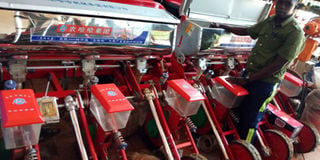Why you should invest in the seed planter

A farm machinery expert from China North Machines explains how a seed planter works. He says the seed planter eases farm work. Photo by Roland D Nasasira
Planting crops in very huge tracts of land with hand hoe can be a tedious activity that could go on for days, increasing the cost of labour for a farmer.
In the normal planting system here in Uganda and other east African countries such as Kenya, Tanzania and Rwanda, farmers till the land twice before sowing the seeds manually.
David Ajuna, a farmer in Pakanyi Sub-county, Masindi District, however, does it differently and easily, using a tractor that saves him a great deal.
When Ajuna was planting his 15-acre farm of groundnuts which he harvested in June 2018, he used a seed planter.
Compared to manual labour where he used to hire farmers to plant the groundnuts casting by hands before he acquired the planter, it would take him approximately one to two weeks to have all the 15 acres planted. This came at an expense.
Seed planter
With the seed planter, he says it simplifies the work of planting because it is admirably fast.
“The seed planter is connected to the tractor that moves it around the field. As the seeds drop from the container, they are covered by the planter so that they are not exposed to heat from the sun. All that the tractor operator does is keep monitoring the seeds in the container to understand when he is to refill,” explains Ajuna.
“I do not have to pay the operator for another phase to drive the planter around the farm to apply fertilisers. The planter can plant seeds and at the same time drop fertilisers so that I do not have to incur extra expenses for fertiliser application,” Ajuna adds.
How the machine works
Douglas Opio, the sales manager at China North Machine, the distributors of the seed planters, says with the machine, seeds to be planted are deposited in a plastic transparent glass or container so that the operator is able to see how much seeds are left in the container as the planter deposits them in the planting field.
Adjusting the seed planter
The seed planter is adjusted because different seeds have different sizes. Seeds such as beans, maize, soybeans, groundnuts lie in the same size and adjustment in the planter when planting while seeds such as sorghum, millet and simsim, among others with small grains, also lie in the same adjustment when planting using the same machine.
“The machine has dropping points and it only releases seeds according to their adjustment. As seeds drop, the top bigger container is equally dropping fertilisers simultaneously,” Opio explains, adding that the planter has six underneath openings and that fertilisers are deposited in the gardens with the help of the gear control the operator applies.
The top container is a stainless steel container that does not succumb to rusting. This means that it can go for many years without the need for replacement.
Burying the seeds
Opio explains further that under the seed bucket lies a sharp pointed metal with openings to dig the ground and allow seeds to be buried or covered in the soil. It also has a double roller which helps to cover seeds to prevent them from being eaten by birds or washed away by agents of erosion such as wind and water.
“It is new efficient technology that is easy to use and operate by any farmer in the region. It can also be used for commercial purposes by hiring it out to farmers who grow crops on large scale and have not yet saved enough to buy their own,” Ajuna advises.
Service and maintenance
Like most modern agricultural machines, the seed planter only requires greasing the chain and gears. It can be operated by one person or farmer who drives the tractor. However, to benefit from its use, it has to be connected to the tractor.
At China North Machine, the seed planter costs Shs23m and comes with a one-year warranty and after sales services by the company. The company offers training to farmers on how to use the planter until they are able to operate it on their own.
About planters
A planter is a farm implement, usually towed behind a tractor that sows (plants) seeds in rows throughout a field.
It is connected to the tractor with a drawbar or a three-point hitch. Planters lay the seeds down in precise manner along rows. Planters vary greatly in size, from 1 row to 54, with the biggest in the world being the 48-row John Deere DB120.




